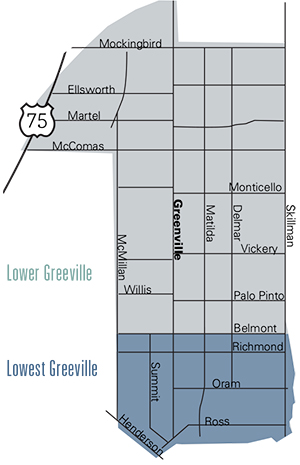Our October cover story is all about the transformation of Lower Greenville, more specifically Lowest Greenville. What’s the difference, and where did the terms originate?
“Lower Greenville” refers to the stretch of Greenville Avenue from Mockingbird to Ross. The term first entered the vernacular in the late ’70s, when the area was experiencing a rejuvenation of business and an influx of new young residents. Its first appearance in the Dallas Morning News was in a column from East Dallas resident and longtime writer John Anders in January 1978, describing Lower Greenville as “less frenetic and more civilized than its north-of-Mockingbird counterpart” as part of an announcement that the “spritely new bar and restaurant San Francisco Rose” had opened.
At first it was only a lowercase adjective, as in “lower Greenville Avenue.” But in an October 1980 story titled “Community unity,” writer Glenna Whitley talks about both “Upper Greenville” and “Lower Greenville,” describing the latter as “serene residential areas [alternating] with neighborhood stores, most occupying structures built long before faceless strip shopping centers became the preferred commercial construction.”
Did this terminology come about organically? (Does anything in Dallas?) Not according to Morning News business columnist Steve Brown, another neighborhood resident who, in May 1983, when he was real estate editor, wrote about developer Shuler-Reese, “the biggest property holder in the Lower Greenville area.” In the article, Brown notes that “Lou Reese takes credit for much of the turnaround on Lower Greenville — a name he coined.”
“Lowest Greenville” refers to the stretch of the avenue from Belmont to Ross. In March 1983, then-writer and current Morning News columnist Steve Blow describes Lower Greenville as “probably the most successfully diverse area of the city, particularly the stretch near Ross Avenue fondly known as Lowest Greenville.” A month later, entrepreneur Shannon Wynne capitalized on this popular term with an ad campaign leading up to his club Tango’s opening that announced its location as “1827 Lowest Greenville Ave.”
The term “Lowest Greenville” became more sparse in the late ’80s and ‘90s, but returned when the bar scene re-emerged at the turn of the century. During the recent zoning changes, neighbors often used the term “Lowest Greenville” to differentiate the area south of Belmont from the rest of Greenville Avenue, says former councilwoman Angela Hunt. And now that Lowest Greenville is trendy once more, its businesses are forming a “Lowest Greenville Collective.”






